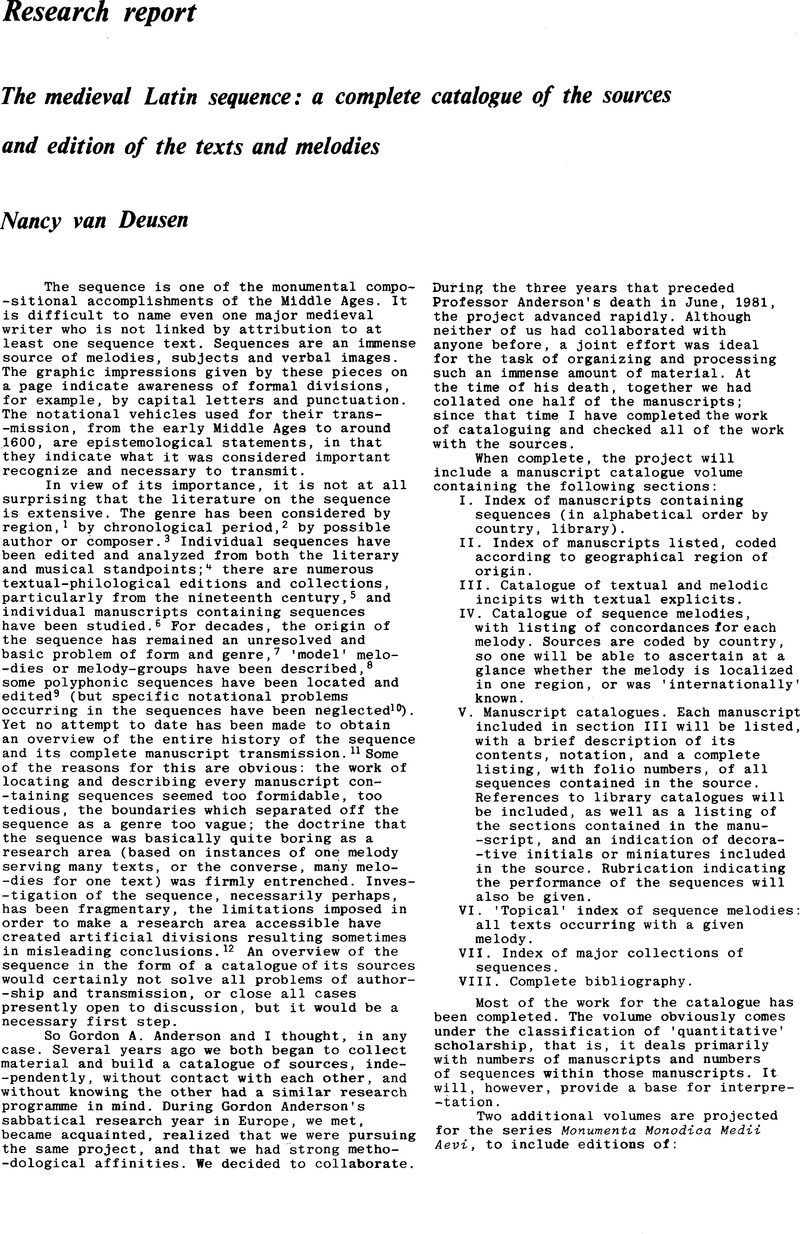Article contents
The medieval Latin sequence: a complete catalogue of the sources and edition of the texts and melodies
Published online by Cambridge University Press: 14 July 2009
Abstract

Information
- Type
- Research Report
- Information
- Copyright
- © The Plainsong and Medieval Music Society 1982
References
Notes
1 Anglès, H.: ‘Die Sequenz und die Verbeta im mittelalterlichen Spanien’, Svensk Tidskrift för Musikforskning, 43 (1961), p.37 Google Scholar.
Bannister, H.: ‘Un trppaire-prosaire de Moissac’, Revue d'histoire et de littérature religieuse, 8 (1903), p.554 Google Scholar.
Brunner, L.: The Sequences of Verona, Bibl.Cap. CVII and the Italian Sequence Tradition (Ph.D. dissertation, University of North Carolina, Chapel Hill, 1977)Google Scholar.
Damilano, P.: ‘Sequenze bobbiesi’, Rivista italiana di musicologia, 2 (1967), p.3 Google Scholar.
Delisle, L.: Les manuscrits de S.Martial de Limoges (Limoges, 1895)Google Scholar.
van Deusen, N.: ‘The sequence repertory of Nevers Cathedral’, Forum musicologicum, 2 (1980), p.44 Google Scholar.
Elfving, L.: Étude lexicographique sur les séquences limousines (Uppsala, 1962)Google Scholar.
de Goede, N.: ‘Utrechter Sequenzen’, Kirchenmusikalisches Jahrbuch, 42 (1958), p.26 Google Scholar.
Husmann, H.: ‘Alleuia, Sequenz und Prosa im altspanischen Choral’, Miscelánea en homenaje a Mons. H. Anglès (Barcelona, 1958–1961), p.407 Google Scholar.
Moberg, C.: Über die schwedischen Sequenzen (Uppsala, 1927)Google Scholar.
Rajeczky, B.: Melodiarum hungariae medii aevi (Budapest, 1956)Google Scholar.
Schubiger, A.: Die Sängerschule St-Gallens von 8. bis 12. Jahrhundert (Einsiedeln, 1858)Google Scholar.
Stäblein, B.: ‘Una sconosciuta sequenza dello stile arcaico in Italia’, Atti del Congiesso Internazionale di Musica Medioevale (Palermo, 1954), p.289 Google Scholar.
Thelen, T.: ‘Kölner Sequenzen’, Kirchenmusikalisches Jahrbuch, 34 (1950), p.15 Google Scholar.
Zwick, G.: Les proses en usage à l'église de St.Nicholas (Immensee, 1950)Google Scholar.
2 Chailley, J.: L'école musicale de St-Martial de Limoges jusqu'à la fin du XIe siècle (Paris, 1960)Google Scholar.
Crocker, R.: The Early Medieval Sequence (Berkeley, California, 1977)Google Scholar.
Crocker, R.: ‘Some 9th-century sequences’. Journal of the American Husicological Society, 20 (1967), p.367 Google Scholar.
Frere, W.: The Winchester Troper from Manuscripts of the Xth and XIth Centuries, Henry Bradshaw Society, 8 (1894)Google Scholar.
Husmann, H.: ‘Das Alleluia “Multifarie” und die vorgregorianischen Stufe des Sequenzengesangs’, Festschrift Max Schneider (Leipzig, 1955), p.17 Google Scholar.
Husmann, H.: ‘Die St.Galler Sequenzentradition bei Notker und Ekkehard’, Acta musicologica, 26 (1954), p.6 Google Scholar.
Husmann, H.: ‘Die Sequenz Duo tres. Zur Frühgeschichte der Sequenzen in St.Gallen und in St.Martial’, Gedenkschrift Jacques Handschin (Strasbourg, 1962), p.66 Google Scholar.
Jammers, E.: ‘Rhythmische und tonale Studien zur älteren Sequenz’, Acta musicologica, 23 (1951), p.1 Google Scholar.
Kohrs, K.: Die aparallelen Sequenzen, Beiträge zur Musikforschung, 6 (Munich, 1978)Google Scholar.
Kunz, L.: ‘Rhythmik und formaler Aufbau der frühen Sequenz’, Zeitschrift für deutsches Altertum und deutsche Literatur, 79 (1942), p.1 Google Scholar.
Kunz, L.: ‘Textrhythmus und Zahlenkomposition im frühen Sequenz’, Die Musikforschung, 8 (1955), p.403 Google Scholar.
Reichert, G.: ‘Strukturprobleme der älteren Sequenz’, Deutsche Vierteljahrsschrift für Literaturwissenschaft und Geistesgeschichte, 23 (1949), p.227 Google Scholar.
Stäblein, B.: ‘Zur Frühgeschichte der Sequenz’, Archiv für Musikwissenschaft, 18 (1961), p.1 Google Scholar.
3 Misset, E. and Aubry, P.: Les proses d'Adam de St.Victor (Paris, 1900)Google Scholar.
Benton, J.F.: ‘Nicholas of Clairvaux and the 12th century sequence with special reference to Adam of St.Victor’, Traditio, 18 (1962), p.149 Google Scholar.
van Waesberghe, J. Smits, ‘Neue Kompositionen des Johannes von Metz (um 975), Hucbalds von St.Amand und Sigeberts von Gembloux?’, Speculum musicae artis: Festschrift Heinrich Husmann (Munich, 1970), p.285 Google Scholar.
Spanke, H.: ‘Die Kompositionskunst der Sequenzen Adams von St.victor’, Studi medievali, new series, 14 (1941), p.1 Google Scholar.
Stäblein, B.: ‘Notkeriana’, Archiv für Musikwissenschaft, 19–20 (1962–1963), p.84 Google Scholar.
von den Steinen, W.: Notker der Dichter (Bern, 1948)Google Scholar.
Weisbein, N.: ‘Le Laudes crucis attollamus de Maître Hugues d'Orleans dit le Primat’, Revue du moyen âge latin, 3 (1947), p.5 Google Scholar.
Wellner, F.: Adam von Sankt-Viktor, sämtliche Sequenzen (Munich, 1955)Google Scholar.
von Winterfeld, P.: ‘Welche Sequenzen hat Notker verfasst? – Rhythmen und Sequenzenstudien’, Zeitschrift für deutsches Altertum Und. deutsche Literatur, 47 (1904), pp.73–100, 321–399 Google Scholar.
4 Bannister, H.: ‘Una sequenza per la purificazione di origine italiana’, Rassegna gregoriana, 2 (1903), p.69 Google Scholar.
Bannister, H.: ‘Una sequenza per l'epifania’, Rassegna gregoriana, 4 (1905), p.5 Google Scholar.
Hoppin, R.: ‘Exultantes collaudemus, a sequence for St.Hylarion’, Aspects of Medieval and Renaissance Music: A Birthday Offering for Gustave Reese (New York, 1966), p.392 Google Scholar.
Kunz, L.: ‘Die Textgestalt der Sequenz “Congaudent angelorum chori”’, Deutsche Vierteljahrsschrift für Literaturwissenschaft und Geistesgeschichte, 28 (1954), p.273 Google Scholar.
Levy, K.: ‘tux de luce: the origin of an Italian sequence’, Musical Quarterly, 47 (1971), p.40 Google Scholar.
Messenger, R.: ‘Sources of the sequence “Scalam ad celos”’. Folia, 2 (1947), p.55 Google Scholar.
Turrin, H.J.: ‘ Aureo flore and the question of dating the tradition of Marian veneration in the medieval West’, Mittellateinisches Jahrbuch, 14 (1979), p.76 Google Scholar.
Vellekoop, K.: Dies ire, dies illa (Bilthoven, 1978) Cf. also N.Weisbein in note 3 above.Google Scholar
5 Many of our concepts and delineations concerning the sequence were generated by the pioneering and monumental text collections of the second half of the nineteenth century, and the first part of the twentieth, especially the Analecta hymnica medii aevi (55 vols., Leipzig, 1886–1922), vols. 1, 7–10, 34, 37, 39–40, 42, 44, 48, 50, 53–55Google Scholar. An indispensable index to this is Analecta hymnica medii aevi – Register, ed. Lütolf, Max (Bern, 1978)Google Scholar.
6 Anglès, H.: ‘Eine Sequenzsammlung mit mensural notation (BN 1343)’, Speculum musicae artis: Festschrift Heinrich Husmann (Munich, 1970), p.9 Google Scholar.
Daux, C.: Le tropaire-prosaire de l'abbaye Saint-Martin de Montauriol, Bibliothèque liturgique, ix (Paris, 1901)Google Scholar.
de Goede, N.: The Utrecht Prosarium (Cod. Ultraject. Univ. Bibl. 417), Monumenta musica neerlandica, vi (Amsterdam, 1965)Google Scholar.
Hesbert, R.-J.: Le prosaire d'Aix-la-Chapelle, Monumenta musicae sacrae, iii (Rouen, 1961)Google Scholar.
Hesbert, R.-J.: Le prosaire de la Sainte-Chapelle, Monumenta musicae sacrae, i (Mâcon, 1952)Google Scholar.
Hesbert, R.-J.: Le tropaire-prosaire de Dublin, Monumenta musicae sacrae, iv (Rouen, 1970)Google Scholar.
Husmann, H.: ‘Die Handschrift Rheinau 71 der Zentralbibliothek Zürich’, Acta musicologica, 38 (1966), p.118 Google Scholar.
Huglo, M.: ‘Un nouveau prosaire nivernais’, Ephemerides liturgicae, 71 (1957), p.3 Google Scholar.
Labhardt, F.: Das Sequentiar Cod.546 der Stiftsbibliothek von St.Gallen und seine Quellen (Bern, 1959–1963)Google Scholar.
Mundo, A.: ‘El proser-troper Montserrat 73’, Scripts et documenta XVII, Liturgica 3 (Montserrat, 1966), p.101 Google Scholar.
Pfaff, H.: Die Tropen und Sequenzen der Hs. Rom Bibl. Naz. Vitt. Em. 1343 (Sessor. 62) aus Nonantola (Dissertation, Munich, 1948)Google Scholar.
Seay, A.: ‘Le manuscrit 695 de la Bibliothèque communale d'Assisi’, Revue de musicologie, 39 (1957), p.10 Google Scholar.
Vecchi, G.: Troparium Sequentiarium Nonantolanum. Cod. Casanat. 1741, Monumenta lyrica medii aevi italica, I. Latina (Modena, 1955)Google Scholar.
Vogt, H.: Die Sequenzen des Graduale Abdinghof aus Paderborn (Münster, Westfalen, 1972)Google Scholar.
7 Blume, C.: ‘Vom Alleluia zur Sequenz’, Kirchenmusikalisches Jahrbuch, 24 (1911), p.1 Google Scholar.
Birkner, G.: ‘Psaume hébraïque et séquence latin’, Journal of the International Folk Music Council, 16 (1964), p.56 Google Scholar.
Dronke, P.: ‘The beginnings of the sequence’, Beiträge zur Geschichte der deutschen Sprache und Literatur (Tübinger Ausgabe), 87 (1965), p.43 Google Scholar.
Duft, J.: ‘Wie Notker zu der Sequenz kam’, Zeitschrift für schweizerische Kircherigeschichte; 56 (1962), p.201 Google Scholar.
Handschin, J.: ‘Über Estampie und Sequenz’, Zeitschrift für Musikwissenschaft, 12 (1929–1930), p.1 Google Scholar; 13 (1930–1), p.113.
von den Steinen, W.: ‘Die Anfänge der Sequenzendichtung’, Zeitschrift für schweizerische Kirchengeschichte, 40 (1946), pp.190–212, 241–268 Google Scholar; 41 (1947), pp.19–48, 122–162.
8 See for example Husmann, H.: ‘Die Alleluia und Sequenzen der Mater-Gruppe’, Kongressbericht: Wien Mozartjahr 1956 (Graz, Cologne, 1958), p. p.276 Google Scholar; Stäblein, B.: ‘Die Sequenzmelodie Concordia und ihr geschichtlicher Hintergrund’, Festschrift Hans Engel (Kassel, 1964), p.364 Google Scholar.
9 Bent, I.: ‘A new polyphonic Verbum bonum et suave ’, Music & Letters, 51 (1970), p.227 Google Scholar.
Dalglish, W.: ‘A polyphonic sequence from Rouen’, Music & Letters, 59 (1978), p.10 Google Scholar.
Gillingham, B.: The Polyphonic Sequences in Codex Wolfenbüttel 677, Musicological Studies and Documents, 35 (Binningen, Switzerland, 1982)Google Scholar.
10 Later notational systems observable in the sequences have been almost totally ignored. The work of Bernouilli, E. in Die Choralnotenschrift bei Hymnen und Sequenzen (Leipzig, 1898)Google Scholar has not been superseded. Also, the visual impression given by the sequence is an area of information which has not been discussed to any extent. (But see Schlager, K.: ‘Beobachtungen zur frtihen Sequenz in ost- und westfränkischer Überlieferung’ in a forthcoming memorial volume for Gordon A. Anderson.)Google Scholar
11 The most comprehensive coverage of sequence manuscripts is Husmann, H.: Tropen- und Sequenzenhandschriften, Répertoire internationale des sources musicales, B/V/1 (Munich, Duisburg, 1964)Google Scholar. As an overview of the genre, the article ‘Sequenz’ by Stäblein, B., Die Musik in Geschichte und Gegenwart, xii (1965), p.522 Google Scholar, is unsurpassed.
12 One of the problems in tracking down ‘victorine’ second-epoch sequences has been that concordances are listed for the text (for instance in the editions in vol.54 of Analecta hymnica) without regard for the fact that a text such as Salve mater salvatoris Vas may have as many as fourteen melodies. In my forthcoming catalogue each melody will be given with all melodic sources, coded by country.
13 Examples of this are included in my article ‘Style, nationality and the sequence in the Middle Ages’, this Journal.
14 This aspect is also discussed in the abovementioned article. See also Handschin, J.: ‘Die Rolle der Nationen in der mittelalterlichen Musikgeschichte’, Schweizer Jahrbuch für Musikwissenschaft, 5 (1931), p.1, especially pp.4–6 Google Scholar.
15 Smalley, Beryl, in The Study of the Bible in the Middle Ages (Oxford, 1951), pp.60f.Google Scholar, remarks that the twelfth-century writers themselves were by no means of one mind concerning the identities and outputs of their own contemporaries.
- 2
- Cited by

